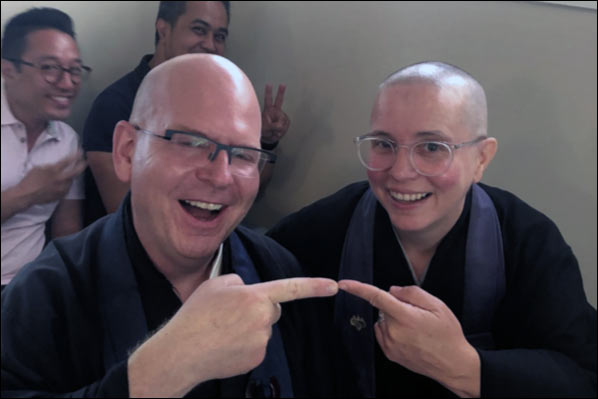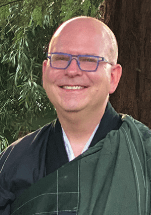
What does it mean to be a Zen Center priest?
April 1, 2023
 by Tom Dharma-Joy Reichert
by Tom Dharma-Joy Reichert
In January, we held a meeting where the current ZCLA priests met with anyone interested in exploring becoming a priest. We have not had such a meeting in quite a long time – in fact, I can’t remember one in the last decade. It was a wonderful meeting that demonstrated the diversity of our priests and their paths of training and service. No two reflections were the same!
Subsequently, the priests met in February – our first meeting as a group since before the pandemic. It was wonderful to get together; in the new reality, we had several people joining us via Zoom – from Brazil, Georgia, Arizona and Central California – along with those of us in person. The priests are in the process of working collectively to develop and clarify certain common guidelines for the priests and priest candidates to consider when someone wants to ordain as a novice priest (a ceremony called shukke tokudo).
As is true with virtually every “path,” the priest path involves ancient principles and practices that we are constantly reexamining and adapting in a modern context. What does it really mean to be a priest? Not just in the abstract, but here, at ZCLA, in 2023? How does the priest path differ from any other training path? Of course, we are in the process of sketching out a series of different training paths that will comprise the Open Palm School; this is intended to clarify the distinctions among various different training paths – the emphasis being on the term “training.” Training involves both external guidance and internal determination and self-initiative; clarifying the various training paths helps both the student and the teacher directionally. But, as you may notice if you are around for any period of time, the distinctions between these paths are not crisply delineated – indeed, they can be very mushy. So, while many people would say that one function specifically reserved for priests is to officiate at liturgical services in the Buddha Hall, in our lineage we have opened that role up to allow certain lay practitioners to lead services as well. Different people have different feelings about this – but that’s how it is, and we invite you to roll those feelings into your practice and to use them to examine your ideas about how things “should” be. As with so much in Zen practice, if you are looking for hard-and- fast, black-and-white answers and rules, you’ve come to the wrong place. Can you hold and enjoy the complexity and let go of fixed ideas?
Fundamentally speaking, the role of a priest is to serve. Of course, everyone who chants the Four Great Bodhisattva Vows is vowing to serve: “Numberless beings/I vow to serve them.” But for a priest, he or she or they have put this vow – specifically, the vow to serve the Sangha – at the center of their lives. As a priest said to me many years ago, when I was considering novice ordination, while service can be optional for lay people, for priests it is not. Personally, I have always carried that perspective with me.
The function of a priest is to serve the Sangha – the Noble Sangha. The Sangha is one of the Three Treasures. It is through practicing together, as a Sangha, that we wake up. It is how we rub off our sharp edges and learn harmonious practice. At ZCLA, we emphasize collective wisdom and awakening. A priest who ordains here is making a deeply rooted vow to nurture the ZCLA Sangha. But, of course, this term “Sangha” has many facets, opening out further and further, and none of them is left out from the vow of service. The vow of service does not have any qualifying footnotes.
Becoming a priest, your relationship to the Sangha changes, in ways both obvious and subtle. While you be- come more visible with this new form and its black robes, mostly the role of a priest is to be invisible, to do what needs to be done without drawing attention to yourself, or seeking notice or praise. A priest is a role of service, but sometimes it can go to your head. Do you think you’re special because you’re a priest? Do Sangha members think so? The ego is subtle and pervasive. Becoming a priest is a wonderful opportunity to see that and to practice with it.
And then there is the “priest archetype,” a set of expectations that may be completely unspoken that permeates your view of yourself and the Sangha’s view of you. What ideas and expectations do you have about what it means to be a priest? Sangha members, what expectations do you have?
Sensei Dharma-Joy is the Head Priest at ZCLA.
